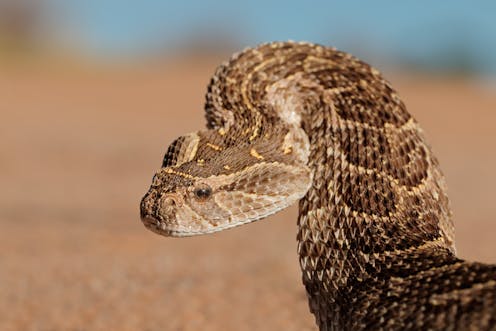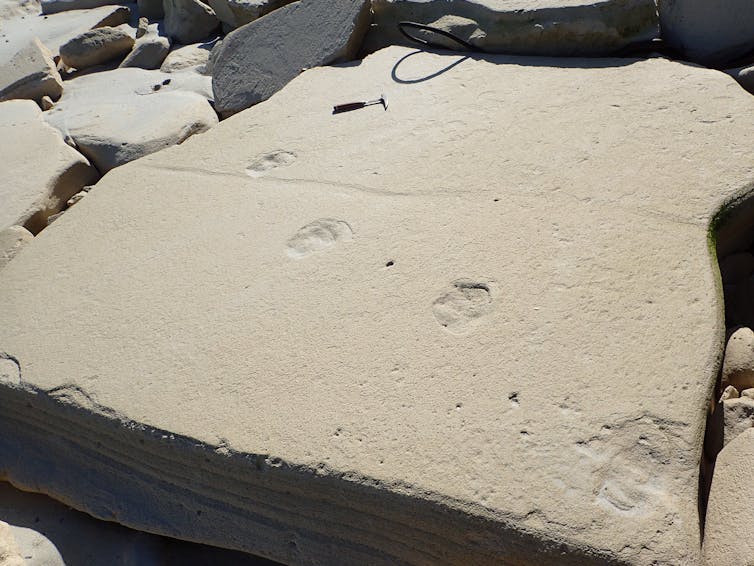
Snakes are familiar, distinctive – and often feared – reptiles. And they’ve been around for a long time: body fossils found in the UK, Portugal and the US stretch all the way back to the late Jurassic period, about 150 million years ago.
Until now, though, there hasn’t been a single description of a surface fossilised snake trace – a mark on a surface that’s become cemented and re-exposed over time – anywhere in the world.
There are probably several reasons for this. One is that the tracks of large quadrupeds (four-legged animals), including dinosaurs, are easier to recognise than those of snakes. Another reason could be that snakes tend to avoid sandy or muddy areas in which their trails could be registered, preferring vegetated terrain. Maybe, as the weight of the snake is distributed over its entire length, the trails are shallow and are not easy to identify.
Or perhaps researchers are not adequately familiar with the types of traces that snakes can create.
We are part of an ichnological team – experts in identifying fossil tracks and traces. In a recently published article in the journal Ichnos, we described the first snake trace in the fossil record, which we found on South Africa’s Cape south coast. It dates to the Pleistocene epoch, and our studies have shown that it was probably made between 93,000 and 83,000 years ago, almost certainly by a puff adder (Bitis arietans).
As this is a world first, our research team was obliged to create a new ichnogenus and ichnospecies, Anguinichnus linearis, to describe the distinctive pattern in the sand registered by the puff adder.
A snake and a buffalo
The puff adder is a not uncommon sight on the Cape south coast today and, with good reason, strikes fear into residents and visitors: its cytotoxic (tissue-destroying) venom can cause the loss of a limb or worse. It habitually suns itself on trails, staying motionless, and then strikes without warning.
À lire aussi : The ultimate in stealth, puff adders employ camouflage at every level
We found the trace fossil in the Walker Bay Nature Reserve (adjacent to Grootbos Private Nature Reserve), just over 100 kilometres south-east of Cape Town.
Intriguingly, a long-horned buffalo – an extinct species – had walked across the same dune surface soon after the snake left its trace. We know this because one of the buffalo’s tracks is superimposed on the puff adder trace, slightly deforming it.

The puff adder and long-horned buffalo traces were found on the surface of a loose slab, 3 metres long and 2.6 metres wide, which had become dislodged and fallen down onto the beach from overlying cliffs. The slab is submerged twice a day by high tides. We were fortunate to discover it when its surface was bare, as repeat visits have shown that it is often covered in algae or by a thick layer of beach sand.
Snakes in motion
Snakes use four main types of locomotion. Each results in distinctive, recognisable traces.
Puff adders are heavy, thick-set snakes with an average adult length of less than a metre. They mostly employ rectilinear motion, leaving a linear, sometimes slightly undulating trace, often with a central drag mark registered by the tail tip. In this form of motion the snake uses its weight and its belly muscles and grips rough areas on the surface with the posterior edges of its scales. It is drawn forwards through the muscular contractions, creating a linear trace.
We also found possible trace evidence at other sites on the Cape south coast of sidewinding and undulatory motion, but this was inconclusive. We will be looking for further, more conclusive evidence.
Filling important gaps
The newly described puff adder traces help fill a gap in the Pleistocene trace fossil record from the region. More than 350 vertebrate tracksites have been identified, of mammals, birds and reptiles. Most of these sites were registered on dune surfaces, which have now become cemented into aeolianites and re-exposed. Our latest find is yet another global first for the Cape south coast.
À lire aussi : First fossil trails of baby sea turtles found in South Africa
With other vertebrate groups, such as dinosaurs and crocodiles, the trace fossil record has substantially augmented the body fossil record, providing new insights. Hopefully this discovery will act as a spur to identify other snake traces from around the world from older deposits, and thus increase our understanding of the evolution of snakes and help to fill a substantial gap in the global trace fossil record.
Les auteurs ne travaillent pas, ne conseillent pas, ne possèdent pas de parts, ne reçoivent pas de fonds d'une organisation qui pourrait tirer profit de cet article, et n'ont déclaré aucune autre affiliation que leur organisme de recherche.
This article was originally published on The Conversation. Read the original article.







